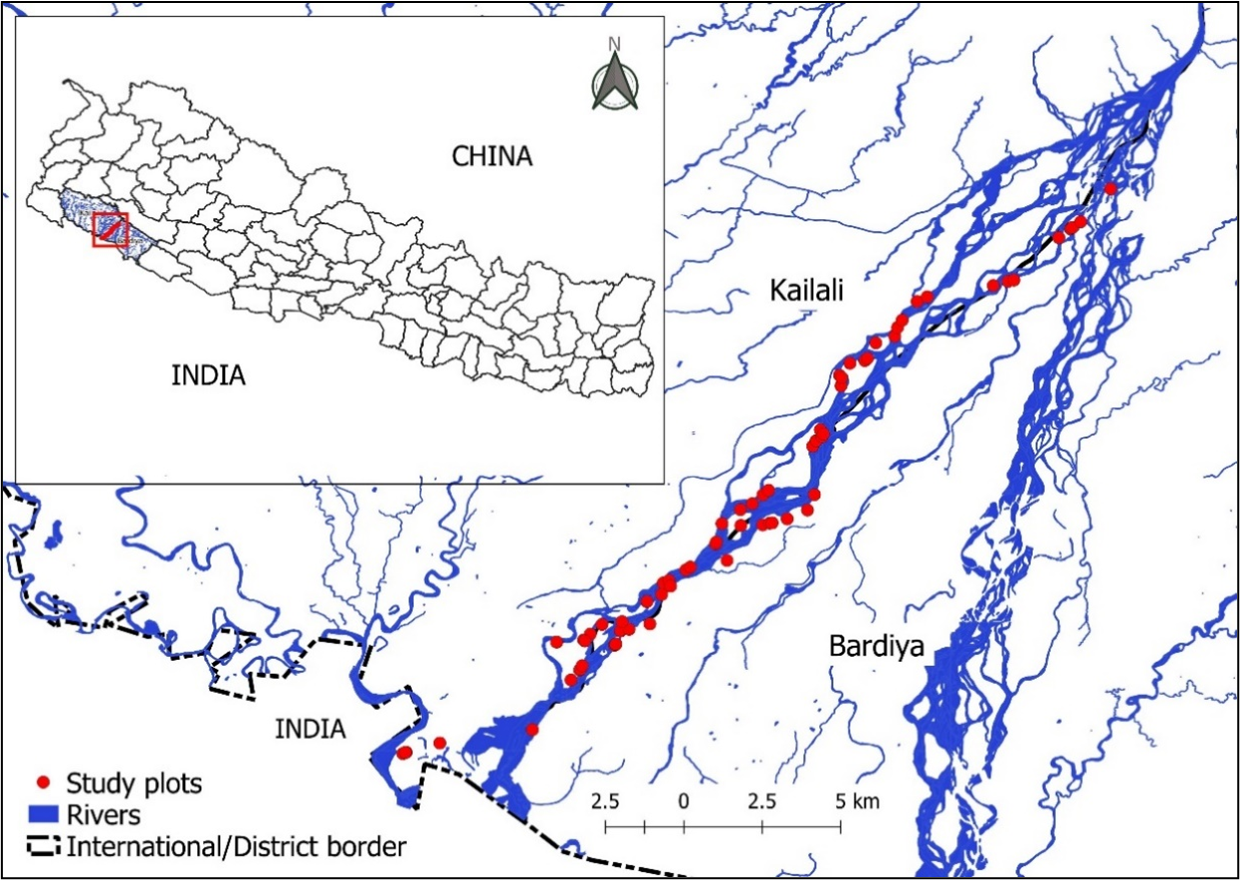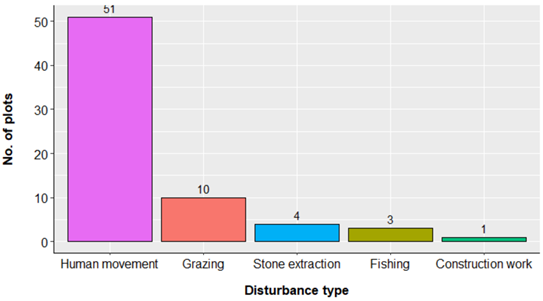IUCN/SSC Otter Specialist Group Bulletin

©IUCN/SCC Otter Specialist Group
Citation: Kathariya, R., Pant, D.R., Gosai, K.R., Sapkota, R.P., and Shrestha, M.B. (2023). Effects of Habitat Variables on the Distribution of Smooth-Coated Otters (Lutrogale perspicillata) along the Kauriala Branch of the Karnali River, Nepal. IUCN Otter Spec. Group Bull. 40 (3): 165 - 174
Effects of Habitat Variables on the Distribution of Smooth-Coated Otters (Lutrogale perspicillata) along the Kauriala Branch of the Karnali River, Nepal
Ramesh Kathariya1, Dipesh Raj Pant2,Kamal Raj Gosai2*, Ramesh Prasad Sapkota1, and Mohan Bikram Shrestha3
1Central Department of Environmental Science, Tribhuvan University, Kirtipur, Kathmandu, Nepal
2Department of Environmental Science, Tri-Chandra Multiple Campus, Kathmandu, Nepal
3Wildlife Research and Education Network, Tokha, Kathmandu, Nepal
*Corresponding Author Email: kamal.gosai@trc.tu.edu.np
Received 1st December 2022, accepted 30th May 2023
Abstract: The Smooth-coated Otter (Lutrogale perspicillata) (SCO) is a semi-aquatic, top predator and a biological indicator of freshwater environments. We assessed the distribution of SCO and its relation to habitat variables in the Kauriala branch of the Karnali River. We searched for evidence of SCO in plots of 100m x 10m in the middle of each of 70 transects of 1 km, on both sides of the river, on a 39km stretch of river. Signs of ocupancy were observed in stretches where the river width ranged from 50 m to 300 m, but river width was negatively associated with probability of occurrence of SCO. Observed signs of SCO were maximal in areas of shrub cover and sandy substrate. Human activity is considered to be the most pressing threat, followed by grazing, stone extraction, fishing and construction activities. Formulation and implementation of a SCO conservation action plan should be prepared to protect the species in the Karnali River.
Keywords: Smooth-coated Otter, habitat, otter distribution, threats
INTRODUCTION
Smooth-coated Otter (Lutrogale perspicillata) (SCO) are semi-aquatic, top chain predator, piscivorous mammals belonging to the family Mustelidae of order Carnivora (Mason and Macdonald, 1986; Houghton, 1987; Nawab and Hussain, 2012b; Khan et al., 2014; Wai et al., 2020). They are social mammals and live in groups to defend territory and and capture prey (Thierry et al., 2021), and are opportunistic feeders (Rajani et al., 2019). Habitat degradation, habitat inadequacy and other human-caused disturbances are a few of the limiting factors determining the abundance of otters (Mason, 1995; de Silva, 2011). The distribution of SCO is little studied in Nepal (Kafle, 2009; Awasthi and Yoxon, 2018), which presents a conservation challenge to conservationists and policymakers alike (Khan et al., 2014).
The SCO is one of three otter species present in Nepal. The two other species are the Eurasian otter (Lutra lutra), and the Small-clawed otter (Aonyx cinereus), although the latter was last documented in the 19th century (Hodgson 1840). The declining population of SCO (de Silva et al., 2016) qualifies it as vulnerable on the IUCN Red List of Threatened Species (Khoo et al, 2023), and it is listed on Appendix I of CITES (CITES, 2022). The SCO has undergone rapid population decline in Nepal (Jnawali et al., 2011). The SCO is protected by the Aquatic Life Protection Act, 2002, but has yet to be listed as a protected species under the National Park and Wildlife Protection Act, 1973.
SCOs in Nepal were first reported by Hodgson (1840). Later on, Houghton (1987) reported on the distribution of SCOs in the Narayani River, the Karnali River and the Mahakali Rivers (Acharya, 2006; BPP, 1995; Evans et al., 1985) and more recently they were reported from the Koshi River after long ambiguity about their presence in the river (Mishra et al., 2022). The species is reported from the Annapurna Conservation Area, Makalu Barun National Park, Bardiya National Park, Chitwan National Park, Shuklaphanta National Park, and Kailali and Kanchanpur districts (Suwal and Verheugt, 1995). SCO habitat use reports vary greatly and range from riverine forests, through rice fields, freshwater wetlands, lakes and rivers to mangrove (Acharya and Lamsal, 2010; Dias et al., 2022). SCO distribution in relation to habitat variables are little studied in Nepal. Within the Karnali River system, SCO studies have been carried out in the eastern branch of the Karnali River, with only limiting studies in western Karnali branch - Kauriala. This study reports on the presence and distribution of SCOs in the Kauriala, the western branch of the Karnali River, along with distribution relation to habitat variables. The findings of this study will be useful in developing a conservation strategy for the Smooth-coated otter in Nepal.
STUDY AREA
The Karnali River, originating from Tibet, China, is snow-fed perennial river and the longest river of Nepal. When it reaches the lowland in Nepal, the river splits into two channels/branches: the Kauriala is the western channel, with relatively less water volume than the main channel in the east (Fig. 1). The study was conducted along a 39 km stretch of the Kauriala River, ranging from 119 m to 170 m above sea level, (28.41680556° N, 81.02777778° E to 28.63966° N, 81.2797073° E). The Karnali river serves as a political boundary between the Kailali District and the Bardia District in the lowlands of Nepal. In the study area, the river runs for about 10 km through the buffer zone area of Bardiya National Park. The annual average temperature of the study area is 24.6 °C and it receives an annual average rainfall of 1822.6 mm. The Karnali River has floodplain and forest as its dominant land type, and boulders, gravel, sand, silt and clay are the soil types (CBS, 2019). The study area has tropical vegetation, mainly comprising Shorea robusta, Acacia catechu, Dalbergia sissoo, Mallotus nudiflorus, Syzygium cumini, Lantana camara, Calamus acanthospathus, Typha angustifolia, Phragmitis sp., and Saccharum spontaneum.
METHODS AND ANALYSIS
A reconnaissance field visit along the Kauriala River- western branch of Karnali River was carried in October 2019 for a general idea of study area, to finalize the study design and to confirm the presence of otters in the study area so the study could be conducted.
Based on this, a 39 km stretch study area was selected where detailed field study was carried in Jan-Feb of 2020. The study was carried by walking along transects, looking on both banks of the river. A total of 70 transects of 1 km along the 39 km river stretch were laid , and a plot of 100 m × 10 m was placed in the middle of each transect (Anoop and Hussain, 2004; Chettri and Savage, 2014; Nawab and Hussain, 2012a); this was examined for signs of occupancy, i.e. scat, track and dens (Acharya and Lamsal, 2010).
Within the plots, habitat variables were studied: substrate type, vegetation type, escape distance, proximity to road and settlement, river width, braided bars (temporary islands) , disturbance intensity (high = sites of stone or sand extraction and less proximity (distance) to settlement <100 m ; moderate = sites of low human activity and medium proximity to settlement 100 m to 500 m ; low = sites of no or limited human activity and high proximity to settlement >500 m), disturbance type (grazing, frequency of human activity, sand and boulder extraction, presence of feral dogs, fishing) - habitat characteristics defined in Khan et al., 2014 and Jha, 2018. Occupancy signs (tracks, scats and grooming sites) were confirmed following an identification guide by de Silva (2016).
A distribution map of SCO was plotted using Arc GIS version 10.8. A Chi-square test of association was done to assess an association between habitat variables and the presence of Smooth-coated Otters. Logistic regression with Poisson error structure was used to assess the association between habitat variables and evidence of the SCO presence. All statistical analysis was done in R (R Core Team, 2016).
RESULTS AND DISCUSSION
Smooth-Coated Otter Occupancy Signs and Distribution
In 70 sampling plots (32 in Bardia District and 38 in Kailali District), occupancy signs were observed in 14 plots (Fig. 2). Tracks (Fig 3A) were observed most frequently (14 plots), followed by scat in 2 plots (Fig 3B), grooming sign (1 plot) and a den (one plot). The occupancy signs were mostly observed on sandy substrate (7 plots), sandy/stone substrate (3 plots), muddy substrate (2 plots) and loamy substrate (2 plots). The distribution of occupancy is 20% of total sampled plots, similar to findings of Hussain and Choudhury (1997).
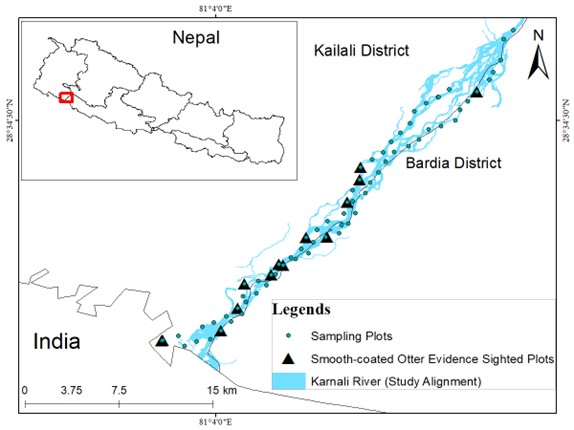
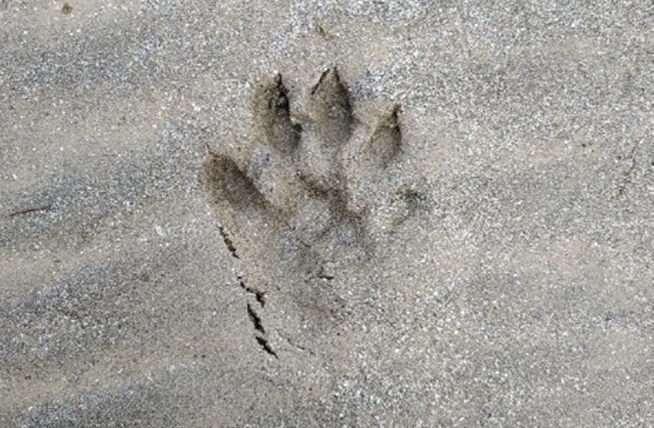

Association of Habitat Variables with SCO Occupancy Signs
Plots with occupancy signs of SCO were observed where river widths ranged from 50 m to 300 m. The presence of the SCO evidence was recorded in the Narayani River with width of the river ranging from 22.8 m to 276.45 m (Acharya et al., 2010). The probability of occurrence of SCO was negatively associated width of the river (Fig. 5). The studies from Anoop and Hussain (2004), Khan et al., (2014), Narasimmarajan et al., (2021) and Jayasurya et al., (2023) also had negative correlation of SCO evidence with the river width.
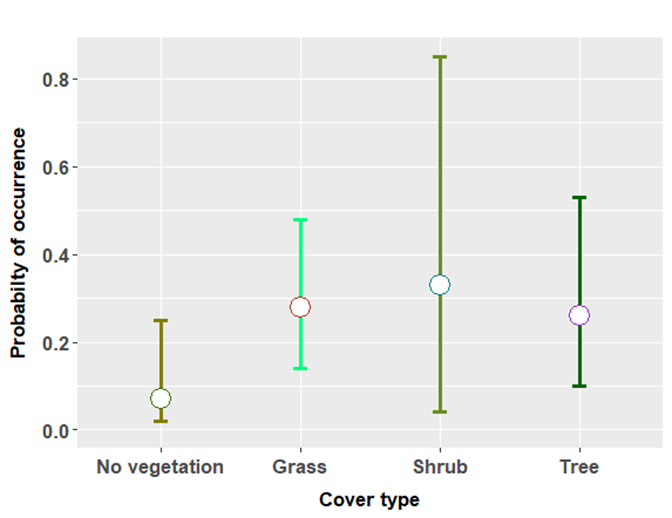
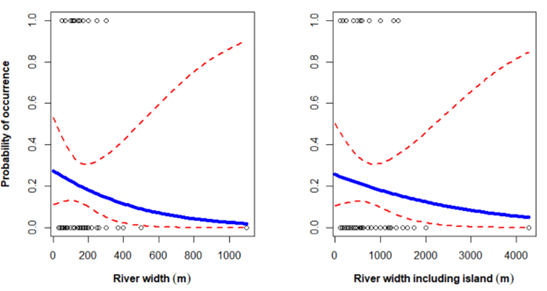
A den site was observed outside the sampling plot along the transect that was at distance of 1.4 m from the river bank. Den sites and scats were observed as far as 12.5 m from the water edge (Hussain and Choudhury, 1997).
Occupancy signs of SCO were observed most often where there was shrub cover (Saccharum sp., Lantana camara), followed by under tree cover (Dalbergia sissoo) and then in grass cover (Cynodon sp.). Signs were observed in areas without vegetation as well (Fig. 4). In the Sind Province of Pakistan, otter sign was documented more on riverbanks thickly vegetated with Typha sp., Saccharum sp., and Phragmites sp., and/or Prosopos juliflora, Tamarix sp., and farmland (Khan et al., 2009). Forest and bank vegetation provides otters with feeding opportunities, as well as a place for foraging, resting and holts (Jha, 2018). Most of the otter signs were recorded in vegetated areas (n=5), followed by floodplains (n=4), gabion walls (n=3) and agriculture land (n=2). Signs of six individuals were observed 50 m from settlements or roads, while signs of two individuals were observed within 50-100 m, 100-250 m, 250-500 m and 500-1000 m from settlements and roads. Out of 14 plots with SCO sign, nine plots had less than 5 m escape distance to vegetative cover, three within 5-10 m and two in 10-25 m (Fig. 6, Fig. 7).
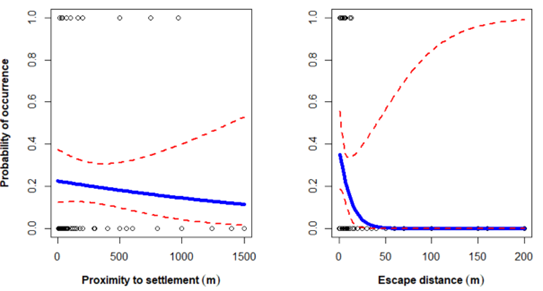
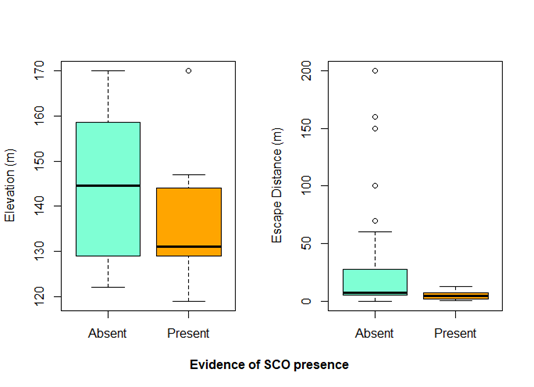
Habitat Disturbance
Human activity is the most pressing problem for SCOs in the study area, followed by grazing, stone extraction, fishing and construction activities (Fig. 8). Ongoing construction works and stone extraction was the most active disturbance type. Livestock grazing and the presence of feral dogs were also potential disturbances. Otter sign been shown to be scarce in disturbed sites (Ali et al., 2010; Nawab and Hussain, 2012a; Chettri and Savage, 2014).
CONCLUSION
SCO presence in the study area was associated with bank vegetation and human activities, including more otter sign where there was more bank vegetation cover. This could relate to ease of escape from human activities and other land-based threats into land and water. Human activities in the study area need to be mitigated to foster SCO presence. Since otter sign has been found relatively more in vegetated areas with shrub cover, ongoing concretization, gabion wall formation and sand and gravel extraction can be taken as being threatening agents for SCOs. Thus, public awareness, regular monitoring of SCOs and conservation initiations are suggested actions in the Karnali Watershed.
Acknowledgements: We are grateful to Department of Environmental Science, Tri-Chandra Multiple Campus for providing us with the logistical support for carrying out this study. We are in debt to the Department of National Parks and Wildlife Conservation and Bardia National Park for giving permission to conduct research in the BNP-Buffer Zone area. We appreciate the local people who provided assistance during the study.
REFERENCES
Acharya, P.M., Lamsal, P., Rajbhandari, S., Lama, H., Lama, B., Pathak, M., Neupane, D., Shrestha, P., Niraula, M. (2010). Status of Otter Distribution in Narayani River, Chitwan National Park, Nepal. A first phase research report submitted to Rufford Foundation, U.K. https://www.researchgate.net/publication/326079915_STATUS_OF_OTTER_DISTRIBUTION_IN_NARAYANI_RIVER_CHITWAN_NATIONAL_PARK_NEPAL
Acharya, P.M. (2006). Otter and wetland conservation in Nepal. In: Rimal, (eds.) Water Resources, Security and Sustainability. SEEP Water, Kathmandu, 144-149.
Acharya, P.M. (2017). Status of Smooth-coated otters Lutrogale perspicillata (Geoffroy, 1826) in the Khauraha River of Bardia National Park, Nepal. Hariyo Ban Programme/WWF Nepal.
Acharya, P.M., Lamsal, P. (2010). A Survey for Smooth-Coated Otter Lutrugale perspicillata on the river Narayani, Chitwan National Park. Hystrix It. J. Mamm 21(2): 203-207. https://doi.org/10.4404/hystrix-21.2-4464
Ali, H., Saleem, R., Qamer, F.M., Khan, W.A., Abbas, S., Gunasekara, K., Hazarika, M., Ahmed, M. S., Akhtar, M. (2010). Habitat evaluation of Smooth-coated Otter (Lutrogale perspicilliata) in Indus Plains of Pakistan using remote sensing and GIS. International Archives of the Photometry, Remote Sensing and Spatial Information Science, Kyoto, Japan. XXXVII (8) https://www.isprs.org/proceedings/xxxviii/part8/pdf/JTS65_20100608145600.pdf
Anoop, K.R., Hussain, S.A. (2004). Food and feeding habits of smooth‐coated otters (Lutra perspicillata) and their significance to the fish population of Kerala, India. Journal of Zoology 266(1): 15-23. https://doi.org/10.1017/S0952836905006540
Awasthi, B., Yoxon, G. (2018). Current status and onservation Threats to Otters in Nepal-A Review. OTTER, The Journal of International Otter Survival Fund 4: 38-44. https://www.researchgate.net/publication/330845870_Current_Status_and_Conservation_Threats_to_Otters_In_Nepal-A_Review
Bashyal, A., Yadav, B.P. (2020). Opportunistic Smooth-Coated Otter (Lutrogale perspicillata) sightings record in Bardia National Park of Nepal. IUCN Otter Spec. Group Bull 37(2): 120-126. https://www.iucnosgbull.org/Volume37/Bashyal_Yadav_2020.html
BPP. (1995). Enumeration of the mammals of Nepal. Biodiversity Profile Project. Technical Publication No. 6, Kathmandu.
CBS. (2019). Environment Statistics of Nepal. Central Bureau of Statistics, Thapathali, Kathmandu, Nepal: Government of Nepal.
Chettri, P., Savage, M. (2014). A Distribution Survey for Otters along a River in Central Bhutan. IUCN Otter Spec. Group Bull 31(1): 65-74. https://www.iucnosgbull.org/Volume31/Chettri_Savage_2014.html
CITES. (2022). Convention on International Trade in Endangered Species of Wild Fauna and Flora. Accessed on 21 November 2022. https://cites.org/eng/app/appendices.php.
de Silva, P.K. (2011). Status of otter species in the Asian Region status for 2007. Proceedings of Xth International Otter Colloquium, IUCN Otter Spec. Group Bull. 28(A): 97-107. https://www.iucnosgbull.org/Volume28A/de_Silva_2011.html
de Silva, P. (2016). A Guide to Identification & Analysis of Prey. The Asian Wetlands and Otters Training Workshop. Zhuhai, China.
Dias, S.J., White, P.J.C., Borker, A.S., Fernandes, N.V. (2022). Habitat selection of smooth‑coated otters (Lutrogale perspicillata) in the peri‑coastal, urbanised landscape of Goa, India. Mamm. Res., 67 : 1-11. https://doi.org/10.1007/s13364-022-00639-1
Evans, M., Heardman, C., Houghton, S., Tiler, C. (1985). An ecological survey of the Narayani River, within the RCNP- A study of the fish distribution and their predators in particular the Smooth Indian Otter (Lutra perspicillata). Edinburgh University Expedition to Nepal, A report to the King Mahendra Trust for Nature Conservation, Nepal.
Hodgson B.H. (1840). Summary description of four new species of Otter. Annals and Magazine of Natural History 5(28): 27-29. https://doi.org/10.1080/00222934009496750
Houghton, S.J. (1987). The smooth coated otter in Nepal. IUCN Otter Spec. Group Bull 2: 5-8. https://www.iucnosgbull.org/Volume2/Houghton_1987.html
Hussain, S.A., Choudhury, B.C. (1997). Distribution and status of the Smooth-coated Otter Lutra perspicillata in National Chambal Sanctuary, India. Biological Conservation 80(2): 199-206 https://doi.org/10.1016/S0006-3207(96)00033-X
Jayasurya, R., Moorthi, M., Sathishkumar, S., Srimathi, R. (2023). Distribution, Habitat selection and Diet of Smooth-Coated Otters (Lutrogale perspicillata) in the Kollidam and Thenpennai Rivers in South India. IUCN Otter Spec. Group Bull. 40(4): 3-15 https://www.iucnosgbull.org/Volume40/Jayasuryal_et_al_2023.html
Jha, R.R. (2018). Distribution Status of Smooth Coated Otters (Lutrogale perspicillata) and Anthropogenic Factors: A Case Study from Karnali Corridor, Nepal. [Dissertation]. Tribhuvan University, Institute of Forestry, Pokhara Campus.
Jnawali, S.R., Baral, H.S., Lee, S., Acharya, K.P., Upadhayay, G., Pandey, M., Joshi, D., Shrestha, R., Joshi, D., Lamichhane, B.R., Griffiths, J., Khatiwada, A.P., Subedi, N., Amin, R. (2011). The Status of Nepal Mammals: The National Red List Series. Kathmandu, Nepal: Department of National Parks and Wildlife Conservation.
Kafle, G. (2009). Review on Research and Conservation of Otters in Nepal. IUCN Otter Spec. Group Bull 26(1): 32-43. https://www.iucnosgbull.org/Volume26/Kafle_2009.html
Khan, W.A., Qasim, M., Ahmad, E., Akbar, G., Habib, A.H., Ali, H., Mueen, F., Chaudhry, A.A., Iqbal, S., Bhaagat, H.B., Akhtar, M., Ahmad, M.S. (2009). A survey of smooth Coated Otters (Lutrogale perspicillata sindica) in the Sindh Province of Pakistan. IUCN Otter Spec. Group Bull 26(1): 15-32 https://www.iucnosgbull.org/Volume26/Khan_et_al_2009.html
Khan, M.S., Dimri, N.K., Nawab, A., Ilyas, O., Gautam, P. (2014). Habitat use pattern and conservation status of smooth-coated otters Lutrogale perspicillata in the Upper Ganges Basin, India. Animal Biodiversity and Conservation 37(1): 69-76. https://doi.org/10.32800/abc.2014.37.0069
Khoo, M., Basak, S., Sivasothi, N., de Silva, P.K. & Reza Lubis, I. (2021). Lutrogale perspicillata. The IUCN Red List of Threatened Species: e.T12427A164579961. https://dx.doi.org/10.2305/IUCN.UK.2021-3.RLTS.T12427A164579961.en
Mason, C.F. (1995). Habitat Quality, Water Quality and Otter Distribution. Hystrix 7: 195-207. https://doi.org/10.4404/hystrix-7.1-2-4070
Mason, C.F., Macdonald, S.M. (1986). Otters: ecology and conservation. Cambridge University Press.
Mishra, R., Lamichhane, B.R., Gautam, B., Ram, A.K., Subedi, N. (2022). Photographic Evidence of Smooth-Coated Otter Lutrogale perspicillata in Koshi Tappu Wildlife Reserve, Nepal. IUCN Otter Spec. Group Bull. 39 (4): 189-195 https://www.iucnosgbull.org/Volume39/Mishra_et_al_2022.html
Narasimmarajan, K., Hayward, M.W., Mathai, M.T. (2021). Assessing the Occurrence and Resource Use Pattern of Smooth-Coated Otters Lutrogale perspicillata Geoffroy (Carnivora, Mustelidae) in the Moyar River of the Western Ghats Biodiversity Hotspot. IUCN Otter Spec. Group Bull. 38 (1): 45-58 https://www.iucnosgbull.org/Volume38/Narasimmarajan_et_al_2021.html
Nawab, A., Hussain, S.A. (2012a). Factors affecting the occurrence of smooth-coated otter in aquatic systems of the Upper Gangetic Plains, India. Aquatic Conserv: Mar. Freshw. Ecosyst. 22: 616-625. https://doi.org/10.1002/aqc.2253
Nawab, A., Hussain, S.A. (2012b). Prey selection by smooth-coated otter (Lutrogale perspicillata) in response to the variation in fish abundance in Upper Gangetic Plains, India. Mammalia 76(1): 57-67. https://doi.org/10.1515/mamm.2011.105
R Core Team. (2016). R: A language and environment for statistical computing. R Foundation for Statistical Computing, Vienna, Austria. URL https://www.R-project.org/ .
Rajani., Kumar, N., Kaswan, K. (2019). Smooth Coated Otter Optimizer: A New Nature Inspired Optimizer. Recent Advances in Computer Science and Communications. 13.
Suwal, R.N., Verheugt, W.J.M. (1995). Enumeration of the mammals of Nepal, biodiversity profiles project technical publication no. 6. Department of National Park and Wildlife Conservation. DNPWC/MoFSC, Kathmandu.
Thierry, L., Marie-Loup, L., Alban, L., Catherine, B. (2021). Solitary versus group living lifestyles, social group composition and cooperation in otters. Mammal Research. 66: 13-31. https://doi.org/10.1007/s13364-020-00536-5
Wai, L., Evans, M.N., Bernard, H., Goossens, B. (2020). Holt-Based Activity Patterns of Smooth-coated Otter (Lutrogale perspicillata) in the Lower Kinabatangan Wildlife Sanctuary, Sabah, Malaysia. IUCN Otter Spec. Group Bull. 37: 20-28. https://www.iucnosgbull.org/Volume37/Wai_et_al_2020.html
Résumé: Effets Des Variables de l’Habitat sur la Distribution de la Loutre à Pelade Lisse (Lutrogale perspicillata) le long du Bras Kauriala de la Rivière Karnali, au Népal
La loutre à pelage lisse (Lutrogale perspicillata) (LPL) est un prédateur supérieur semi-aquatique et un indicateur biologique des milieux d’eau douce. Nous avons évalué la distribution de la LPL et sa relation avec les variables d’habitat dans le bras Kauriala de la rivière Karnali. Des preuves de la présence de la LPL ont été recherchées sur les deux berges le long d’un tronçon de rivière de 39 km comprenant 70 transects de 1 km où des parcelles de 100 m × 10 m ont été définies au milieu du transect. Des indices de présence ont été observés sur les tronçons où la largeur de la rivière varie de 50 à 300 m. Cependant, la largeur de la rivière induisait une probabilité négative d’occurrence de la LPL. Les indices de présence observés de LPL étaient maximaux dans les zones de couverture arbustive et de substrat sablonneux. Les mouvements humains sont considérés comme la menace la plus pressante, suivis par le pâturage, l’extraction de pierre, la pêche et les activités de construction. Un plan d’action de conservation de la LPL devrait être rédigé et mis en œuvre afin de protéger les espèces de la rivière Karnali..
Revenez au dessus
Resumen: Efectos de las Variables de Hábitat en la Distribución de la Nutria Lisa (Lutrogale perspicillata) a lo Largo de la Rama Kauriala del Río Karnali, Nepal.
La Nutria Lisa (Lutrogale perspicillata) (NL) es un predador tope semi-acuático, y un indicador biológico en ambientes de agua dulce. Evaluamos la distribución de NL y su relación con las variables de hábitat en la rama Kauriala del Río Karnali. Buscamos evidencias de NL en ambas orillas a lo largo de un tramo de 39 km de río, con 70 transectas de 1 km, disponiendo cuadrantes de 100 m x 10 m en el medio de la transecta. Observamos signos de ocupación en tramos en los que el ancho del río variaba entre 50 m y 300 m, pero el ancho del río se asociaba negativamente con la probabilidad de ocurrencia de NL. Los signos observados de NL fueron máximos en áreas con cobertura de arbustos y sustrato arenoso. El movimiento de personas fue considerada la amenaza que ejerce más presión, seguido por el pastoreo, la extracción de rocas, la pesca, y las actividades de construcción. Se debería preparar un plan de acción para la conservación de la NL, para proteger a la especie en el Río Karnali.
Vuelva a la tapa
सार
खैरो ओट (Lutrogale perspicillata) एक अर्ध-जलीय, शीर्ष शिकारी र जलीय पारिस्थितिकिय प्रणालीको जैविक सूचक हो । हामीले कर्णाली नदीको कौरियाला शाखामा खैरो ओटको वास-स्थान बारे अध्य्यन गर्यौं । हामीले कर्णाली नदीको ३९ कि.मि. को दुवै तटमा प्रत्येक १ कि.मि. को ट्रान्जेक्ट (Transect) को मध्य विन्दुमा एउटा १०० × १० मि. को प्लट (Plot) बनाएर जम्मा ७० वटा ट्रान्जेक्ट सर्वेक्षण गरेको थियौ । ओटले नदीको चौडाइ ५० मिटर देखि ३०० मिटर सम्म रहेको क्षेत्रहरूमा अधिक उपयोग गरेको पाईयो, तर नदीको चौडाइसँग खैरो ओटको उपस्थितिको सम्भावनासँग नकारात्मक सम्बन्ध देखियो। खैरो ओट स-साना बुट्यानहरु भएको र बलौटे माटो भएको क्षेत्रहरूमा बढी देखियो । त्यस क्षेत्रमा मानव गतिविधि सबै भन्दा ठूलो खतरा भएको देखियो , त्यसपछि चरन, ढुङ्गा उत्खनन, माछा मार्ने र भौतिक निर्माण जस्ता गतिविधिहरूले पनि ओटको वास-स्थानमा असर गरेको देखियो । यो अध्ययनले कर्णाली नदीमा रहेका प्रजातिको संरक्षणकालागि प्रजाति संरक्षण कार्य योजना तर्जुमा र कार्यान्वयन गर्नुपर्छ भन्ने निष्कर्ष प्रस्तुत गर्दछ ।
सुरुमा फर्कनुहोस्





